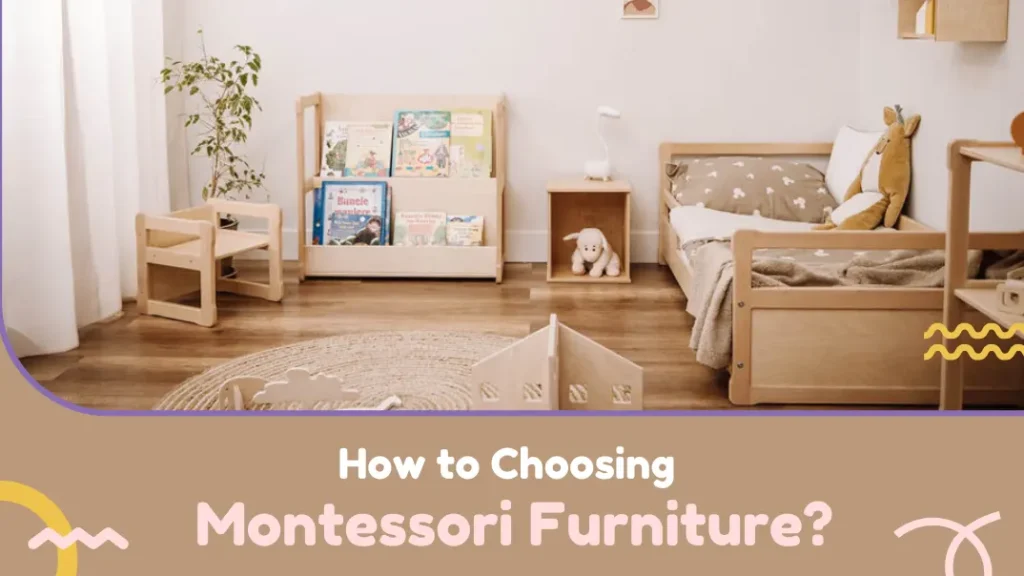Are you considering a Montessori education for your child? If so, then choosing Montessori furniture is an important part of creating a great learning environment. Montessori furniture offers a practical, child-centered solution promoting growth, independence, and creativity.
When designing a Montessori classroom and choosing Montessori furniture, keep in mind that the environment should exude a beautiful homey atmosphere.
Whether you are setting up a Montessori classroom or a home environment, we will guide you through choosing Montessori furniture in this article.
What is Montessori Furniture?
Montessori furniture refers to specially designed pieces that align with the educational philosophy of Maria Montessori. This furniture prioritizes children’s independence, safety, and natural learning tendencies. Unlike traditional furniture, Montessori items are crafted to be child-sized, functional, and accessible, enabling children to explore and interact with their environment without relying on adults for assistance.
Montessori furniture is more than just functional; it’s purpose-driven. Every piece is designed to foster autonomy, from low shelves that store toys within reach to small tables that allow children to sit and eat independently. By integrating natural materials and minimalist designs, Montessori furniture creates a calming and inviting atmosphere supporting focus and learning.
Principles of Montessori Furniture Design
Child-Centered Functionality
The foundation of Montessori furniture lies in its ability to meet the child’s needs. Every detail, from height to weight, is tailored to ensure ease of use. For instance, a low shelf not only makes toys accessible but also teaches children to return items to their designated place, fostering a sense of responsibility and order.
Tables and chairs designed for small hands and shorter statures empower children to sit and stand independently. This focus on child-centered functionality promotes confidence and encourages them to engage actively in daily activities.

Natural and Eco-Friendly Materials
Montessori furniture often uses natural, sustainable materials like solid wood, bamboo, or cork. These materials are durable and safe for children to touch, feel, and explore.
To ensure safety, these materials are typically finished with non-toxic, water-based paints or lacquers, making them free from harmful chemicals. This adherence to eco-friendly standards reflects the Montessori philosophy of respecting nature and fostering environmental responsibility in children.
Simplicity and Minimalism
Montessori furniture embraces clean lines and minimal designs, eliminating distractions and unnecessary embellishments. This simplicity supports a child’s focus and enhances their ability to concentrate on tasks. Additionally, minimalist furniture creates a sense of calm, essential for maintaining an orderly learning environment.
Connection to the Environment
Natural wood finishes help children connect to their surroundings and create a calm, harmonious atmosphere. Montessori furniture avoids bright, overstimulating colors, which can distract children from focused learning.
Things to Pay Attention to When Choosing Montessori Furniture
Selecting Montessori furniture requires thoughtful consideration. Here are the key factors to guide your decision-making process:

Age
Montessori furniture is designed to grow with your child, so choosing pieces that align with their current developmental stage is essential.
- For infants (0–12 months): Opt for low beds that allow freedom of movement and mats for safe tummy time.
- For toddlers (1–3 years): Look for child-sized chairs, low tables, and shelves that toddlers can use to access toys or books independently.
- For preschoolers (3–6 years): Furniture such as activity stations and practical life tools (e.g., small sinks or kitchen tools) help develop motor and life skills.
- For school-age children (6+ years): Adjustable desks and multi-purpose furniture adapt to their growing needs while supporting their academic and creative pursuits.
Materials
The choice of materials plays a significant role in Montessori furniture. Natural materials like wood are highly recommended for durability, aesthetic appeal, and tactile qualities. Avoid plastic furniture, which may not provide the same sensory benefits or durability.
Additionally, ensure all finishes are non-toxic to protect your child’s health. Eco-friendly certifications can offer extra assurance when purchasing furniture.
Don’t just dream it, design it! Let’s chat about your custom furniture needs!
Functionality
Each piece of furniture should serve a specific purpose. Low shelves, for example, make toys and books accessible to young children, while child-sized chairs encourage independent eating or crafting.
When evaluating functionality, consider whether the furniture supports the Montessori principle of independence. If a child can use the item with minimal adult intervention, it’s likely a good fit.
Durability
Children’s furniture must withstand daily use, spills, and occasional rough handling. To ensure safety and longevity, consider robust construction methods, such as reinforced joints and smooth edges.
Investing in high-quality furniture may have a higher upfront cost, but it pays off in the long run by avoiding frequent replacements.
Types of Montessori Furniture for Different Ages
Montessori furniture adapts to the developmental stages of children, ensuring that each item aligns with their abilities, needs, and interests. Below, we’ve expanded each age group to provide a wider selection of Montessori-inspired furniture options.
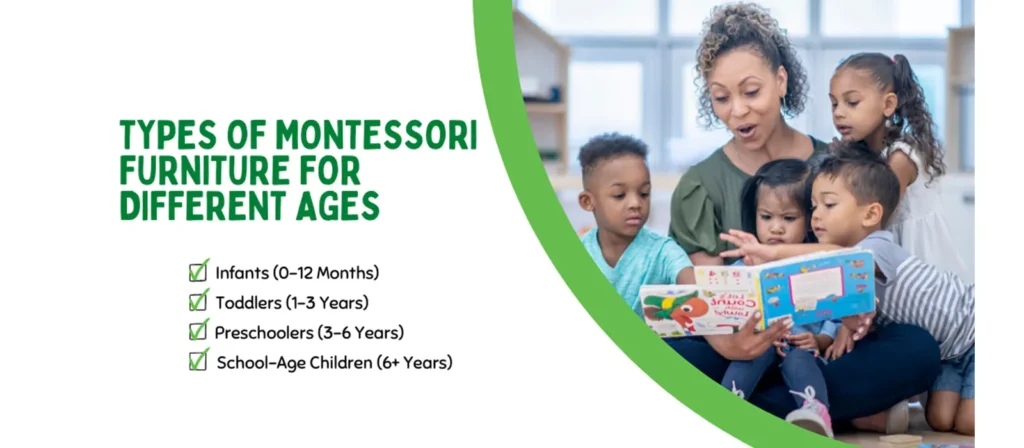
Infants (0–12 Months)
For infants, the focus is on creating a safe, nurturing space that encourages exploration and sensory development. Here are essential Montessori furniture items for this stage:
- Low Beds: Floor beds or Montessori cribs allow babies to develop mobility and independence as they learn to move in and out independently.
- Play Mats and Cushions: Provide soft and supportive surfaces for tummy time, rolling, and crawling.
- Mirror with Barre: A wall-mounted mirror with a low bar encourages infants to observe their movements and practice pulling up to stand.
- Low Shelving: Compact shelving units display toys or sensory materials within a baby’s reach, fostering engagement with their environment.
- Weaning Chairs and Tables: These miniature dining sets help infants transition to solid foods in a child-friendly manner.
Toddlers (1–3 Years)
Toddlers are rapidly developing independence, motor skills, and curiosity. Their furniture should support their desire to explore and interact with their environment:
- Child-Sized Tables and Chairs: Small dining or activity sets are ideal for meals, crafts, and learning activities. Look for sturdy options with rounded edges for safety.
- Low Shelving Units: Open shelves with bins or baskets make toys and books accessible, encouraging organization and responsibility.
- Step Stools or Learning Towers: Adjustable platforms enable toddlers to safely reach kitchen counters or bathroom sinks, fostering practical life skills.
- Climbing Furniture: Montessori climbers like the Pikler triangle or arch allow toddlers to explore movement, develop motor skills, and build confidence.
- Toy Storage Cabinets: Low cabinets with drawers or compartments promote independence in selecting and tidying toys.
- Soft Seating: Child-sized bean bags or foam chairs offer cozy spaces for reading or quiet time.
Don’t just dream it, design it! Let’s chat about your custom furniture needs!
Preschoolers (3–6 Years)
Children become more focused on structured learning and refining practical skills at this stage. The furniture should support their growing independence and creative pursuits:
- Activity Desks with Storage: Adjustable desks with space for pencils, art supplies, and books help preschoolers focus on learning activities.
- Practical Life Furniture: Items like a child-sized broom, mop, or laundry setup teach self-care and responsibility.
- Montessori Kitchen Stations: Miniature kitchen furniture, including a low sink, cutting board, or functional stovetop, encourages participation in meal preparation.
- Low Bookcases: Open, forward-facing shelves make books easy to see and select, fostering an early love for reading.
- Stackable Chairs and Tables: Lightweight and stackable options provide flexibility for group activities or solitary work.
- Imaginative Play Structures: Wooden dollhouses, puppet theaters, or dress-up racks inspire creativity while keeping materials neatly organized.
- Climbing and Balance Equipment: Advanced climbing tools, balance boards, or stepping stones enhance physical development and coordination.
School-Age Children (6+ Years)
As children grow older, their furniture needs to evolve to accommodate more complex activities and prolonged periods of focus. Here are some options for this age group:
- Adjustable Desks and Chairs: Ergonomic desks and chairs that grow with the child ensure comfort during homework, art, or other projects.
- Bookshelves with Categorized Storage: Larger shelving units help older children organize books, school supplies, and personal items effectively.
- Multi-Functional Furniture: Items like loft beds with built-in desks or storage systems maximize space and functionality.
- Workstations: Dedicated work areas with ample desk space, corkboards, or cubbies support focus and creativity.
- Seating Options for Relaxation: Bean bags, floor cushions, or hammocks provide cozy spaces for reading or quiet reflection.
- Hobby or Craft Stations: Specialized tables for sewing, painting, or building models cater to hobbies and skill development.
- Sports and Fitness Furniture: Indoor gymnastics bars, climbing walls, or compact exercise equipment support physical activity for older children.

Benefits of Using Montessori Furniture at Home or in the Classroom
Montessori furniture offers numerous benefits for children, parents, and educators. Let’s explore these advantages in detail:
1. Cultivate Children’s Independence
The design of Montessori furniture allows children to interact with their environment without relying on adults. Low shelves, for instance, enable them to choose and return toys independently, building confidence and self-reliance.
2. Create an Orderly and Calm Environment
A clutter-free environment is essential for children’s mental well-being. Montessori furniture promotes organization through its simple, streamlined design, helping children learn to maintain order in their surroundings.
3. Encourage Movement and Coordination
Physical activity is a key component of development. Items like climbing frames or low tables encourage natural movements, improving children’s coordination and motor skills.
4. Encourage Exploration and Curiosity
Open, accessible spaces foster curiosity by inviting children to explore materials and engage with their environment. This setup nurtures a love for learning and discovery.

5. Enhance Concentration
By eliminating unnecessary distractions, Montessori furniture helps children develop focus and concentration, which are critical skills for academic success.
6. Build Problem-Solving Skills
Furniture incorporating interactive elements—such as puzzles or practical life activities—challenges children to think critically and find solutions independently.
Tips for Montessori-Style Home Furnishing
Creating a Montessori-inspired home requires intentional design and a focus on accessibility. These tips will guide you in transforming your space into an environment that nurtures your child’s development:
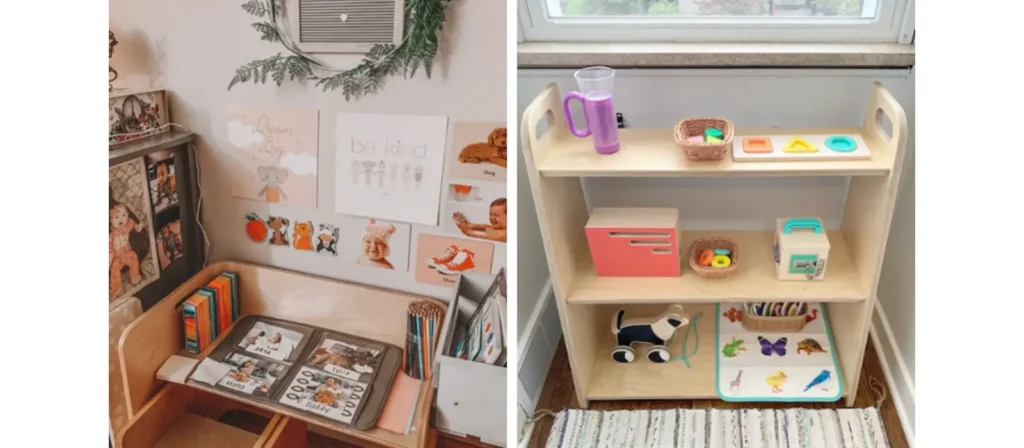
1. Prioritize Child-Friendly Accessibility
One of the core principles of Montessori design is that children should be able to access their environment independently. This means everything in your home should be within their reach, easy to use, and safe for them to interact with. This level of accessibility empowers children and fosters their sense of independence, which is central to the Montessori philosophy.
- Use Low Shelves and Open Storage
Shelves should be low enough for children to access and interact with independently. This allows them to choose their toys, books, and materials without help. A great way to do this is by using open shelving units that display items at eye level. This also encourages children to take responsibility for organizing and putting things away after use. - Child-Sized Furniture
Furniture like chairs, tables, and benches should be scaled to your child’s size. This promotes comfort and fosters a sense of belonging and independence. A child-sized table allows them to engage in activities like art, meals, or puzzles at their level. - Accessible Storage for Personal Items
When a child’s belongings (like clothes, shoes, or backpacks) are within easy reach, they start practicing self-care and responsibility. Installing low hooks or a child-height wardrobe gives them the independence to dress themselves or store items.
2. Choose Functional and Multi-Purpose Furniture
Montessori furnishings should be functional, meaning each piece serves a specific purpose in fostering your child’s independence and development. In addition, multi-purpose furniture is ideal for small spaces, helping to maximize the utility of each item in your home.
- Multi-Functional Pieces
Look for furniture that serves more than one purpose. A low bookshelf can double as a room divider or a play surface. A table with drawers can function as both an activity desk and storage. - Practical Life Furniture
Montessori is deeply focused on practical life skills. Consider adding furniture that enables your child to engage in real-world tasks. - Adjustable Furniture
Adjustable pieces, such as height-adjustable tables and chairs, allow the furniture to grow with your child. This ensures that the furniture will continue to serve them for years, adapting to their developmental needs.
Your perfect classroom is one click away!
3. Embrace Natural Materials and Neutral Tones
Montessori design embraces natural materials like wood, cotton, and wool. These materials provide a sensory-rich experience and create a calm and peaceful environment.
- Use Wood, Cotton, and Other Natural Materials
Wood is a popular material for Montessori furniture because it is durable, tactile, and aesthetically pleasing. Look for furniture made from natural, untreated wood or non-toxic finishes. - Neutral and Earthy Color Palettes
A key aspect of the Montessori style is a focus on simplicity and calmness, achieved through neutral and earthy tones. Soft, muted colors create a peaceful environment that is not overstimulating. These colors also allow the child’s creativity to take center stage. - Avoid Bright, Overstimulating Colors
Bright colors or overly busy patterns can distract and overwhelm young children. It’s better to choose soft colors that blend well and promote a calming atmosphere, encouraging children to engage in focused activities.
4. Design Spaces for Different Activities
A Montessori home should be organized to encourage the child’s engagement with different activities, from reading and learning to playing and practical tasks. Each space should serve a specific purpose, allowing children to focus on one activity at a time without distractions.
- Create Defined Zones for Activities
Creating different zones or corners in your home can help children understand the function of each space. A quiet reading nook, a practical life area, and a sensory play zone can all be designated within the same room but separated by furniture arrangement. - Encourage Independent Play with Open Play Areas
An open living room or playroom space allows children to move freely and engage in open-ended play. Keeping the area free of clutter and distractions allows children to focus and be creative with their toys or activities. - Incorporate Practical Life Stations
A Montessori-style home often includes areas where children can engage in practical life activities. These activities allow children to practice self-sufficiency while helping with household tasks.

5. Keep the Environment Minimalist
A cluttered environment can overwhelm children and make it difficult to focus or engage with the task. Minimalism in Montessori design promotes order, peace, and concentration.
- Regularly Rotate Toys and Materials
Avoid overwhelming children with too many toys or items at once. Instead, rotate toys or learning materials regularly, offering a new selection every few weeks. This keeps the environment fresh and helps children engage more deeply with the materials. - Create a Flowing, Uncluttered Layout
Arrange furniture to create a smooth, uncluttered flow throughout the space. This encourages children to move easily from one activity to another without obstacles. - Declutter and Simplify
Regularly declutter the home, removing items that no longer serve a purpose or distract from the environment’s peacefulness. Focus on keeping only what’s necessary to support your child’s development.
DIY Options for Montessori Furniture
Creating Montessori furniture doesn’t have to break the bank. DIY projects can be a cost-effective and rewarding way to furnish your home while aligning with Montessori principles.
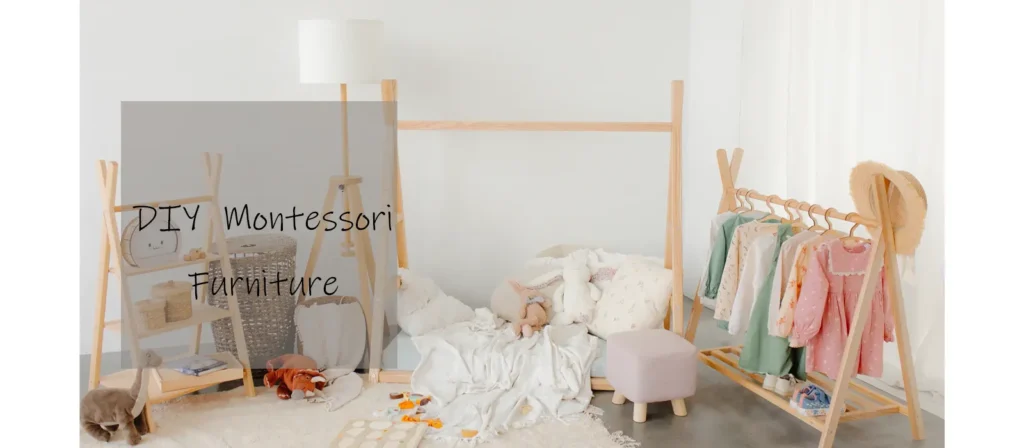
1. Build Your Low Shelves
Low shelving units are a staple in Montessori spaces. You can create simple, child-friendly shelves using affordable wood and basic tools.
- Steps to Build Low Shelves:
- Measure and cut wood planks to the desired dimensions.
- Assemble the frame using screws or brackets.
- Sand and finish the wood with non-toxic varnish for a smooth, safe surface.
2. Convert Existing Furniture
Repurpose furniture you already own to suit your child’s needs. For example, an old cabinet can be transformed into a Montessori wardrobe by adding low-hanging rods and bins.
- Conversion Ideas:
- Shorten table legs to create a child-sized table.
- Remove doors from cabinets to make open shelving.
- Add wheels to a low cart for portable storage.
3. Make DIY Activity Stations
Activity stations can be tailored to your child’s interests and developmental stage. You can create affordable options with minimal effort, from art easels to practical life tools.
- Examples of DIY Stations:
- A small handwashing station using a basin and water dispenser.
- An art station with a paper roll, crayons, and storage bins.
- A sensory play station with trays for sand or water activities.
4. Use Pallets for Multi-Functional Furniture
Wooden pallets are versatile and budget-friendly. With some creativity, they can be turned into beds, tables, or storage units.
- DIY Pallet Furniture Ideas:
- A floor bed frame using stacked pallets.
- A wall-mounted bookshelf made from disassembled pallet slats.
- A modular seating area with cushions on top of pallet platforms.
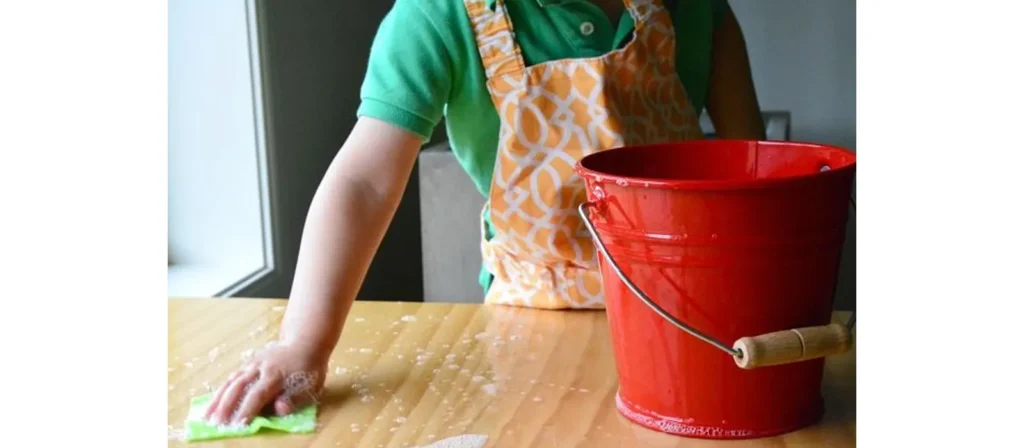
Montessori Furniture Care and Safety Tips
Maintaining Montessori furniture is essential to ensure safety, durability, and functionality. Here’s how to keep your furniture in top condition:
- Regular Cleaning: Children interact with their furniture frequently, so cleanliness is crucial. Use safe, non-toxic cleaning products to keep surfaces hygienic.
- Inspect for Wear and Tear: Regularly check your furniture for damage or loose parts that could pose safety hazards.
- Use Protective Finishes: If you’re making or repairing furniture, use non-toxic finishes to protect the surfaces while keeping them safe for children.
- Anchor Heavy Furniture: Ensure your child’s safety by anchoring tall or heavy items to the wall, like shelves or cabinets. This prevents tipping accidents, especially in homes with active toddlers.
- Teach Proper Usage: While Montessori furniture is designed to be child-friendly, teaching your child how to use it appropriately is essential.
Conclusion
Choosing Montessori furniture doesn’t have to be complicated. You can create an environment that promotes independence and growth by focusing on child-centered design, safety, durability, and customization. Partnering with a reliable supplier like us ensures quality and peace of mind. Let’s build better learning spaces together!

